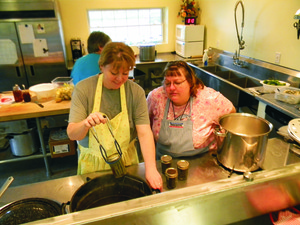04 Feb Fri 2011
Canning Tip #12: Choosing a Good Canning Pot
A key tool for canning is the pot you cook in. It's important that you choose a pot with these characteristics:
1. Nonreactive. Your pot should be made of a nonreactive substance. I.e., not aluminum or some old baked-on enamel that has started cracking! Those were pots your grandma may have used, but believe me, she would have killed for a good stainless steel pot! Aluminum and regular steel impart their metallic flavors to foods (especially acidic ones like fruits) when they are heated together. The metallic flavor gets stronger after the jars are processed, too!
So what pots ARE good to use? Stainless steel is the most common. It's more expensive than an enamel-over-steel kettle, but it won't chip like enamel. Enamel pots are anywhere between $10 and $30, while stainless usually starts at $65 for a 12-quart pot and goes up to $200. The price rises as the capacity grows.
Also, Le Creuset pots are fine. Their enamel-over-cast iron feature is baked on so hard that it is unlikely to chip. A Le Creuset pot big enough to accomodate preserving is going to be one really expensive pot, though! The largest Le Creuset I own was $40 at an estate sale. It is $350 retail, though, and only accomodates a small batch of jam (7 or so jars).
Copper works well, too, but there are some tricks to combining the fruit and sugar before it hits the pot. Tricky (and the priciest alternative!).
2. Weight. Don't select a cheap, light-weight pot. A good stainless pot will have 18/10 steel with a try-ply bottom. This is cheap insurance! When your child runs in the kitchen screaming with a splinter in his finger, or a long-long friend calls, you're going to forget you're in the middle of canning. Life goes on, right? A thick-bottomed pot protects your ingredients from scorching easily. Raspberry seeds LOVE to collect at the bottom of a pot. They sit there and scorch quite easily if you don't stir a lot. A try-ply bottom lets them sit there for a while before they scorch.
3. Height and width. A good canning pot has to have high sides and a wide width. The height accomodates the immense amount of foam and bubbles that occur when fruits release their water. And for the water to evaporate, you have to have a large surface area -- thus a wide pot. The wider the pot, the faster the jam cooks. And that is important because quite a few fruits taste like unpleasant, overcooked caramel when they've cooked too long.
My pick? For a canning novice, choose a 16-qt. stainless steel pot, 18/10 thickness, try-ply bottom. It will last years!


What fun I had yesterday learning all the great skills of canning jams, veggies and so much more. Sonya has a great way of teaching and making everyone feel comfortable in her industrial kitchen while enjoying a great day with new friends.